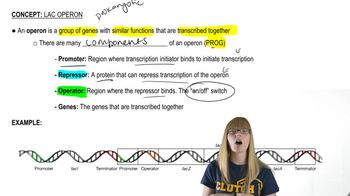Here are the essential concepts you must grasp in order to answer the question correctly.
Inducers and Gene Regulation
Inducers are molecules that initiate gene expression by binding to a repressor protein, thereby allowing transcription to occur. In the context of lactose metabolism in bacteria, lactose acts as an inducer for the lac operon, which encodes enzymes necessary for the breakdown of lactose. Understanding how inducers function is crucial for grasping the mechanisms of gene regulation.
Recommended video:
The Lac Operon
The lac operon is a well-studied model of gene regulation in bacteria, particularly Escherichia coli. It consists of genes that encode proteins required for lactose metabolism, along with regulatory elements that control their expression. The operon is activated in the presence of lactose, demonstrating how environmental factors influence gene expression.
Recommended video:
Experimental Evidence in Genetics
Experimental evidence in genetics often involves techniques such as gene knockout, reporter assays, and biochemical assays to demonstrate the role of specific molecules in gene regulation. In the case of lactose as an inducer, experiments showed that the presence of lactose led to increased expression of lac genes, providing direct evidence of its role in regulating gene expression related to lactose metabolism.
Recommended video:




